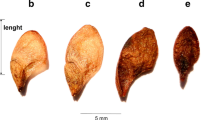Splash seed dispersal by raindrops was investigated for plants in southern Japan. Nine families, 10 genera and 19 species were confirmed as raindrop-dispersed plants. The 10 genera were Gentiana, Gratiola, Chrysosplenium, Mazus, Mitella, Ophiorrhiza, Sagina, Sedum, Trigonotis and Veronica. The method of splash rain dispersal in these species was clarified. Raindrop-dispersed species were all small herbaceous plants with a vertical pedicel and an apically opening fresh capsule when the seeds mature. Open capsules were cup-shaped or boat-shaped and can accommodate raindrops easily. The raindrops splashed the seeds from the capsule. In general, the seeds weighed very little, but they were heavier than powder or dust seeds dispersed by wind. A strong negative correlation was found between seed weight and the number of seeds per capsule. In the case of Trigonotis brevipes (Maxim.) Maxim., raindrops were received into the cup-shaped calyx-tube and dispersed the fruitlets. Some species, such as Gentiana thunbergii (G. Don) Griseb., Gentiana zollingeri Fawcett and Ophiorrhiza japonica Blume, had hydroscopic movement capsules that opened widely only when wet. Raindrop-dispersed plants were found in various habitats. For example, some plants grew together on rocks along the mountain torrents where splash water could easily be caught. The results of the laboratory and field experiments indicated that the dispersal distance of seeds by raindrops was 1 m or less. For small herbaceous plants, splash dispersal by rain might be an effective and advantageous method of seed dispersal because dispersal is not affected by plant height.
Similar content being viewed by others
REFERENCES
Baker H. G. (1972) Seed weight in relation to environmental conditions in California. Ecology 53: 997–1010.
Brodie H. J. (1951a) The splash-cup dispersal mechanism in plants. Canadian Journal of Botany 29: 224–234.
Brodie H. J. (1951b) The splash-cups of Polyporus conchifer. Canadian Journal of Botany 29: 593–596.
Brodie H. J. (1955) Springboard plant dispersal mechanisms operated by rain. Canadian Journal of Botany 33: 156–167.
Buller A. H. R. (1942) The splash-cups of the bird’s nest fungi, liverworts and mosses. Transactions of the Royal Society of Canada III 36: 159.
Dodge B. O. (1941) Discharge of the sporangioles of bird’s nest fungi. Mycologia 33: 215–219.
Friedman J., Gunderman N. & Ellis M. (1978) Water response of the hygrochastic skeletons of the true rose of Jericho (Anastatica hierochuntica. L.). Oecologia 32: 289–301.
Gibbs R. D. (1950). Botany. An Evolutionary Approach. The Blakiston Company, Philadelphia.
Gutterman Y. (1990) Seed dispersal by rain (ombrohydrochory) in some of the flowering desert plants in the deserts of Israel and the Sinai Peninsula. Mitteilungen aus dem Institute für Allgemaine Botanik Hamburg 23b: 841–852.
Kerner A. (1891) Pflanzenleben. Bibliogr Institute, Wien.
Martin G. W. (1927) Basidia and spores of the Nidulariaceae. Mycologia 19: 239–247.
Müller P. (1955) Vervreitungsbiologie der Blutenpflanzen. Hans Huber, Bern.
Nakagoshi N. & Soga S. (1981) A study of the alpine vegetation on the Shirouma Mountains in central Japan, with special reference to seed ecology. Hikobia supplement 1: 341–358 (in Japanese with English summary).
Nakanishi H. (1988a) Mechanical seed dispersal of herbaceous plants in southwestern Japan. Hikobia 10: 129–133.
Nakanishi H. (1988b) Myrmecochores in warm-temperate zone of Japan. Japanese Journal of Ecology 38: 169–176.
Nakanishi H. (2000) Ecological characteristics of epizoochorous plants in southern Japan. Journal of Phytogeography and Taxonomy 48: 25–33.
Ridley H. N. (1930) The Dispersal of Plants throughout the World. Reeve, Ashford.
Savile D. B. O. (1953) Splash-cup dispersal mechanism in Chrysosplenium and Mitella. Science 117: 250–251.
Ulbrich E. (1928) Biologie der Fruchte und Samen (Karpobiologie). Springer Verlag, Berlin.
van der Pijl L. (1972) Principles of Dispersal in Higher Plants, 2nd edn. Springer Verlag, Berlin.
Author information
Authors and Affiliations
Corresponding author
About this article
Cite this article
Nakanishi, H. Splash seed dispersal by raindrops. Ecol Res 17, 663–671 (2002). https://doi.org/10.1046/j.1440-1703.2002.00524.x
Received:
Accepted:
Issue Date:
DOI: https://doi.org/10.1046/j.1440-1703.2002.00524.x




